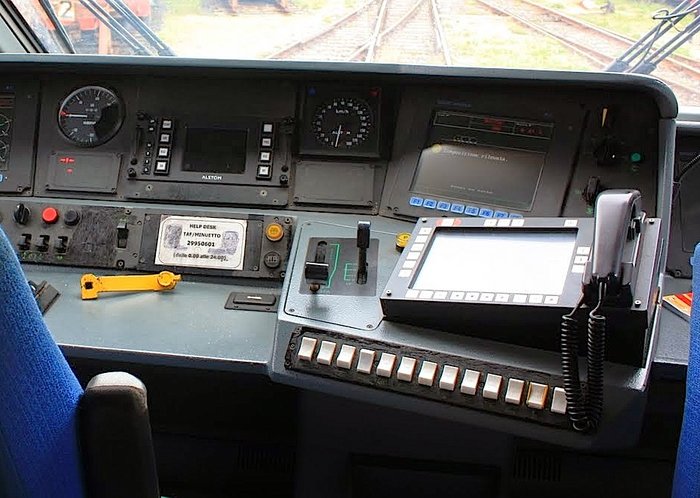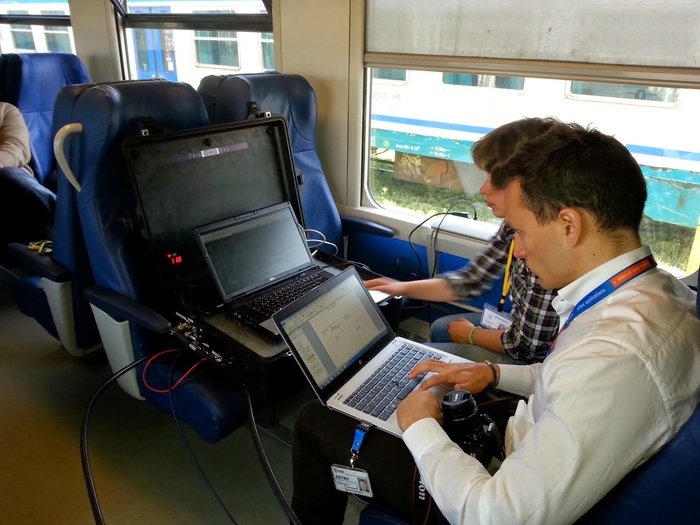Satellite-based signalling systems ready to roll
The 3InSat consortium recently completed a successful trial run of its integrated rail signalling system. It took place in Sardinia in February of thsi year on the Cagliari-San Gavino railway line using a passengers train with the 3InSat system operating in shadow mode. The train covered a distance of some 7,300 km during the trial period.
 The system is based on the European Rail Traffic Management System (ERTMS) signalling standard. Instead of using the standard balises (electronic beacons) along the rail bed to determine the train location, the 3InSat system uses the GNSS Location Determination System (LDS) designed and developed by Ansaldo STS, which is is compliant with existing rail safety standards. The new technology is the result of the 3InSat rail signalling project, supported by ESA through the ARTES Integrated Applications Promotion programme. These activities are also part of Space4Rail, an initiative supported by ESA to develop and commercialise space-based technology for the rail industry.
The system is based on the European Rail Traffic Management System (ERTMS) signalling standard. Instead of using the standard balises (electronic beacons) along the rail bed to determine the train location, the 3InSat system uses the GNSS Location Determination System (LDS) designed and developed by Ansaldo STS, which is is compliant with existing rail safety standards. The new technology is the result of the 3InSat rail signalling project, supported by ESA through the ARTES Integrated Applications Promotion programme. These activities are also part of Space4Rail, an initiative supported by ESA to develop and commercialise space-based technology for the rail industry.
“The successful outcome of the demonstration campaign confirms the viability of GNSS technology for rail,” says Salvatore Sabina, Head of Satellite projects of Ansaldo STS. “We now are ready to implement the virtual balise concept for the railway industry”.
The trial site in Sardinia comprised two local reference stations installed in Decimomannu and Samassi railway stations and the Vital Safety Server, or VSS, which implements the Radio Block Center and Track Area LDS Server functions. This was installed in the rail network's Cagliari Control Center.
The train used was equipped with an ERTMS EVC and the LDS on-board unit. For the radio communications, the system used a combination of 3G/4G, the TETRA private radio network, and satellite-based communications. The 3InSat consortium has also tested an IP-based multi-bearer radio telecommunication subsystem as an alternative to the rail industry's GSM-R network, which is now considered to be obsolete.
The demonstration campaign confirmed the satisfactory operation of the ASTS ERTMS system, in particular in Full Supervision Operation Mode, which meant that the on-board signalling subsystem took complete responsibility for safe movement of the train.
The deployment of a pilot line in Sardinia, in collaboration with RFI as part of the certification process, will be the next major step towards the adoption of GNSS as the basis for further evolution of the ERTMS ecosystem.
In a related development, a privately-owned iron ore mining operation in Western Australia, Roy Hill, commissioned ASTS to build a new railway line for transferring iron ore to the harbour at Port Hedland. It will be the first freight system in the world to use a SIL 4 satellite-based train control system, and is based on the technology developed during the 3InSat project.
“ERMTS has been a major breakthrough in the improvement of rail management, but, up to now, the physical infrastructure required – the track-side balises and so forth – has entailed a significant investment, and this has prevented its wider deployment” says ESA's Michele Castorina, Technical Officer for the 3InSat project and coordinator of ESA's Space4Rail initiative. “Using a satnav and satcoms-based solution should significantly reduce the costs of implementing ERMTS”.
“Compared to a traditional system, 3InSat cost benefit analysis demonstrated that the LCC (Life Cycle Cost) of a satellite-based train control system will be much lower, in the range of 20-40%, including the cost of the new equipment and related investments” says Francesco Rispoli, Ansaldo STS Manager, and Satellite Technology Manager and General Director of Radiolabs, an R&D partner of 3InSat. “For just the telecommunications component, the target LCC reduction compared to ground-based systems, assuming ten-year operations, is 30% to 60% including the amortisation of investments to customise and certify the terminals.”
 “3InSat has demonstrated the potential economic benefits of satellite technology for the evolution of ERTMS, so the time is now ripe for developing satellite-based products customised for rail applications,” he says.
“3InSat has demonstrated the potential economic benefits of satellite technology for the evolution of ERTMS, so the time is now ripe for developing satellite-based products customised for rail applications,” he says.
The worldwide market for rail signalling systems is large and growing, with growth driven particularly in areas where new railway lines need to be built or modernised. In Europe, there are some 57,000 km TEN-T corridors where ERTMS deployment is a priority and about 60,000 km of local and regional lines that need to be modernised.
For local and regional lines, satellite-based ERTMS would not only improve safety, but also offer an economically viable alternative to existing systems. In regions of the world where maintenance costs are prohibitive owing to environmental conditions, such as South Africa, Russia, Australia, and Brazil, satellite-based technologies could be rapidly deployed to greatly reduce the need for track-side equipment.


